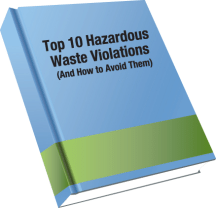
In honor of throwback Thursday I decided to rehash one of the first things we ever wrote about on this blog. The ten most common violations incurred by hazardous waste generators. As you can most likely infer, these items are ones you’ll want to make sure are not happening at your company. The ten items are listed and explained below. And if you’d like a little more information about the violations and how to avoid them you can also check out our eBook on the subject.
1. Open Container Violations – An open container includes containers that have tinfoil caps, funnels, or loose caps. Containers must be closed at all times unless they are being filled or emptied.
2. Storage Area Accumulation Date Violations – Remember, containers of hazardous waste in a 90 or 180-day storage area must be marked with an accumulation date.
3. Universal Waste Violations – This includes management of wastes such as batteries and lamps.
4. Used Oil Labeling Violations – Remember that any container or tank utilized to hold used oil should be labeled “Used Oil.”
5. Storage Area Labeling Violations – Containers in a 90 or 180-day storage area must be marked with the words “Hazardous Waste” as well as generator name and address, accumulation start date, contents, physical state, and hazardous properties.
6. Satellite Accumulation Area Labeling Violations – Always remember that a container must be labeled after the first drop of waste is added.
7. Contingency Planning Violations – Make sure to have you plan in place and that all employees know what to do if needed.
8. Failure to Perform Weekly Inspections of Hazardous Waste Storage Areas – Fairly self-explanatory, make sure you have weekly inspections done.
9. Failure to Have a Hazardous Waste Reduction Plan On-Site – A hazardous waste reduction plan (often referred to as a waste minimization plan) is required for all hazardous waste generators.
10. Failure to Make a Hazardous Waste Determination – It is imparitive to remember that a hazardous waste determination must be made for each and every waste generated on your site.
More News From Heritage
-
3/7/25
Celebrating Our Team: Employee Appreciation Shoutouts
Learn about how we celebrated Employee Appreciation Day
-
3/6/25
Accelerating Action: Celebrating International Women’s Day
Learn about how we're celebrating International Women's Day
-
2/21/25
Heritage Announces East Liverpool, Ohio 2025 Environmental Grant Program
Learn about our East Liverpool Ohio grant opportunity!
-
2/18/25
Heritage Environmental Services Announces James (Shelby) Marlow as Chief Financial Officer
Heritage Environmental Services announced today that James (Shelby) Marlow will join the organization as Chief Financial Officer.
-
1/31/25
January Community Engagement Initiative: Home/Work Energy Reduction
Learn about our January community engagement initiative
-
1/29/25
Heritage Environmental Services Announces Chris Ebeling as Chief Commercial Officer
Heritage Environmental Services announced today that Chris Ebeling will join the organization as Chief Commercial Officer.
-
1/28/25
Heritage Environmental Services Addresses Industry Challenges with New State-of-the-Art Shredder
Heritage Environmental Services announced a new state-of-the-art shredding unit.
-
1/7/25
Navigating e-Manifest: What You Need to Know About Hazardous Waste Compliance
Learn about the e-Manifest Third Rule changes that begin January 22, 2025







